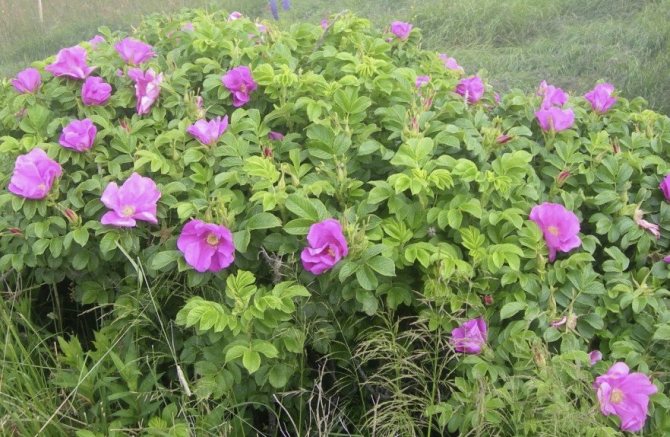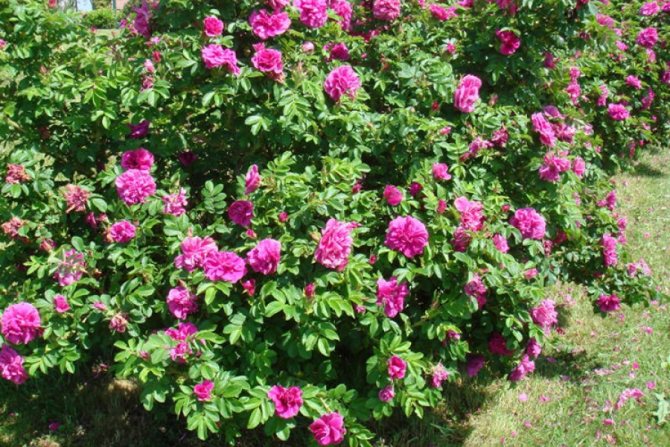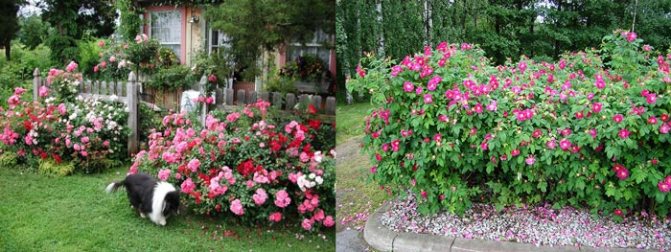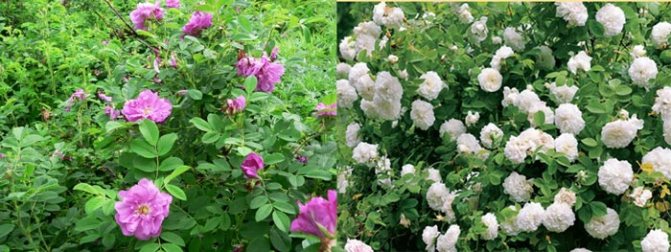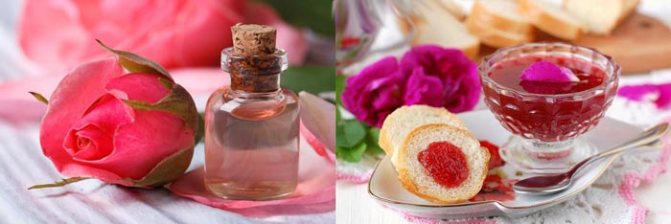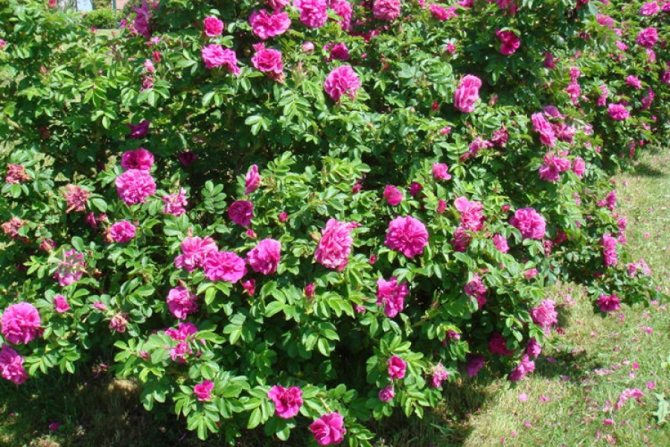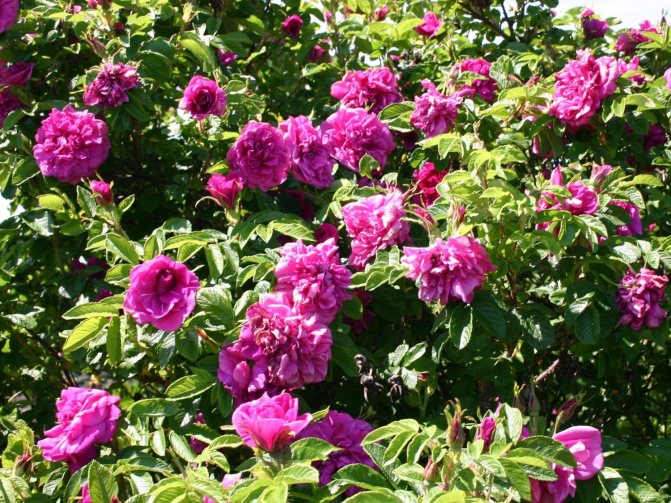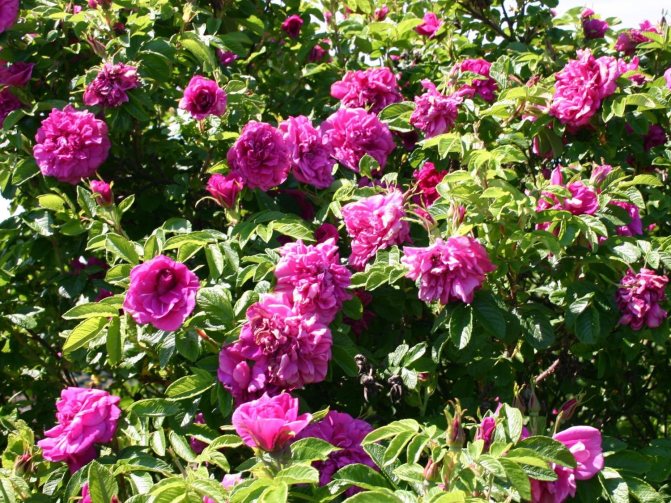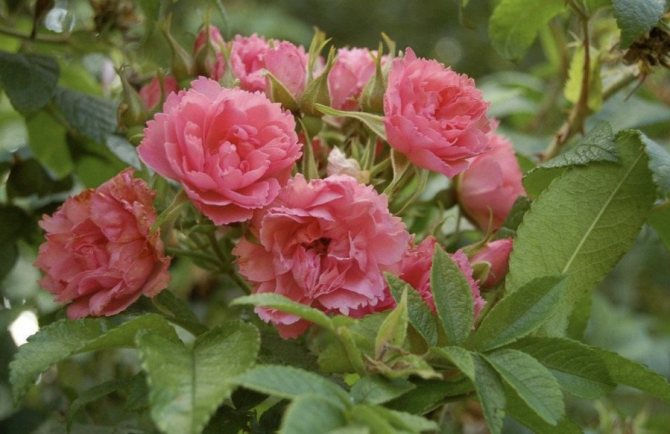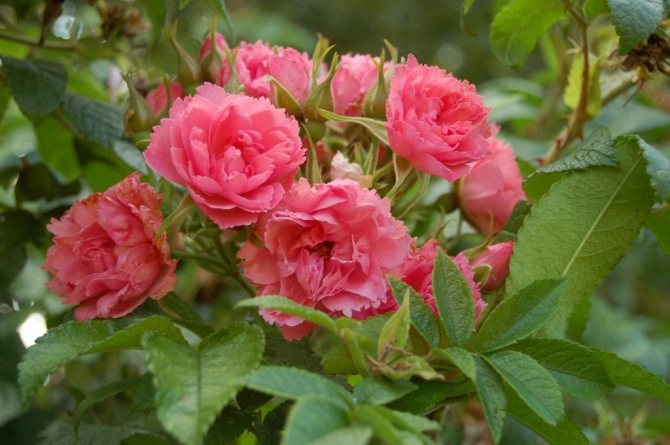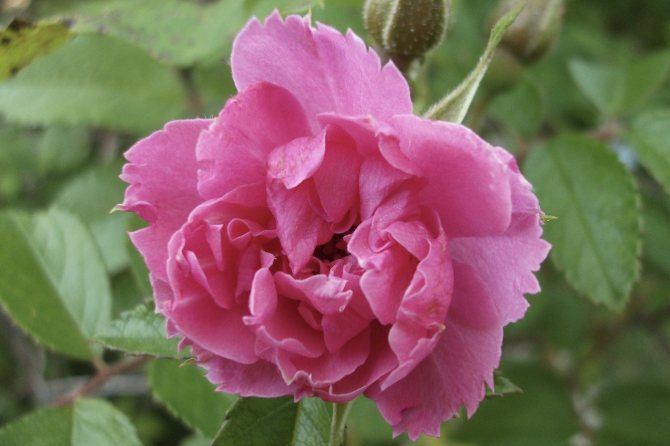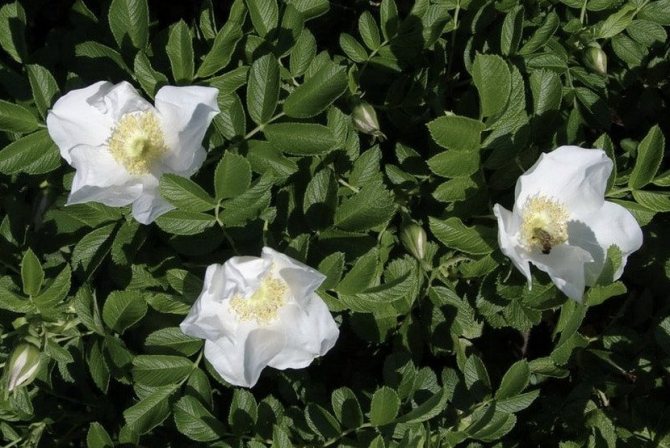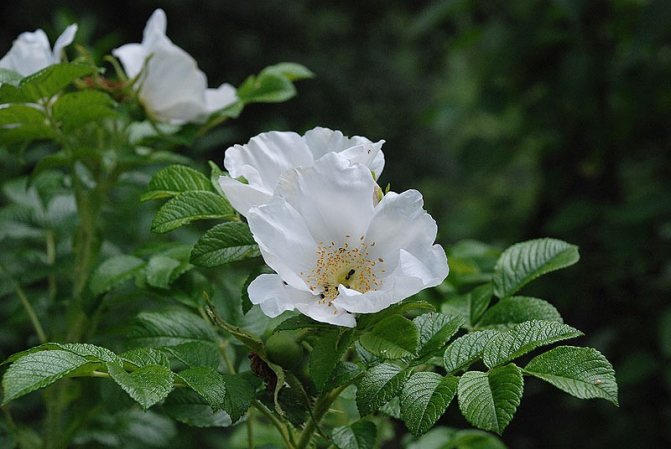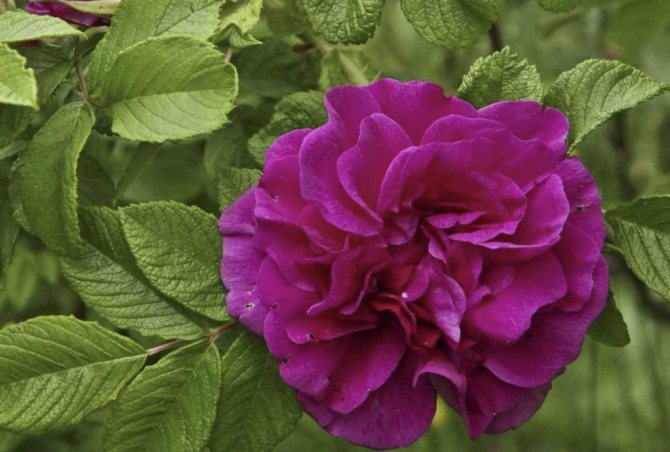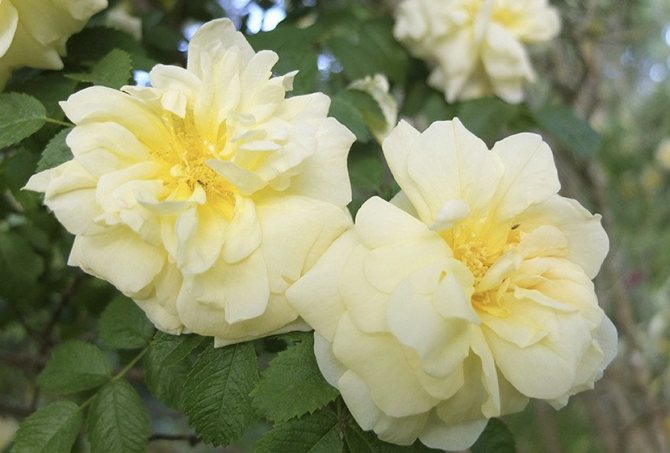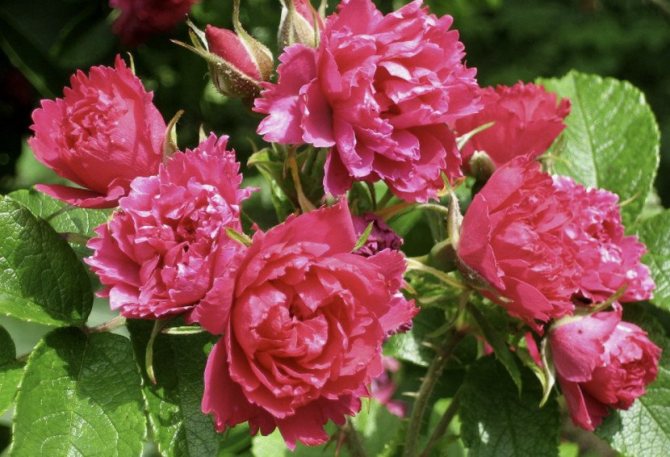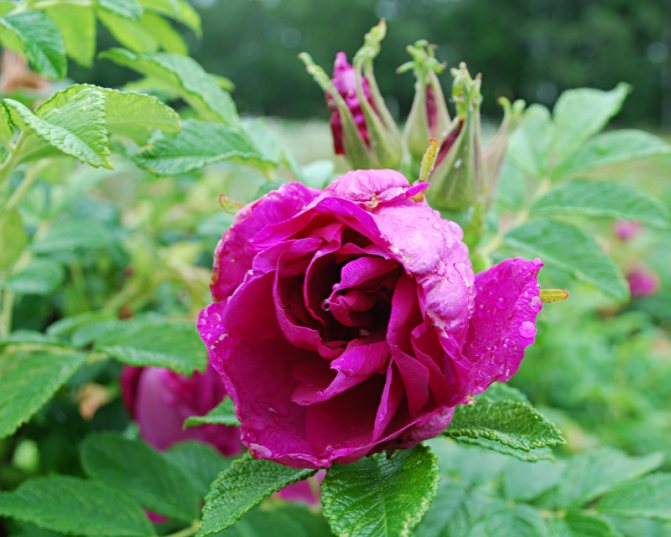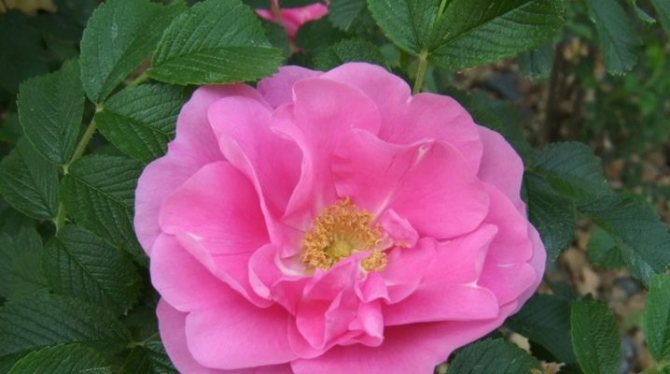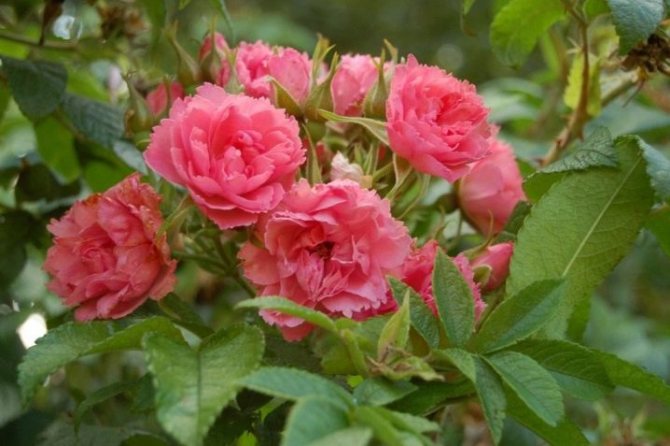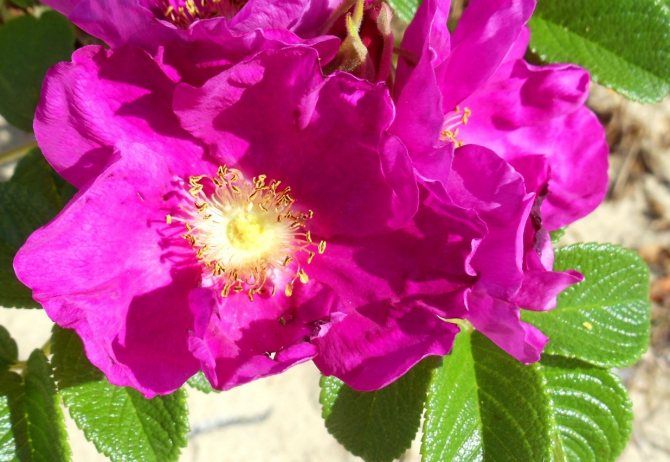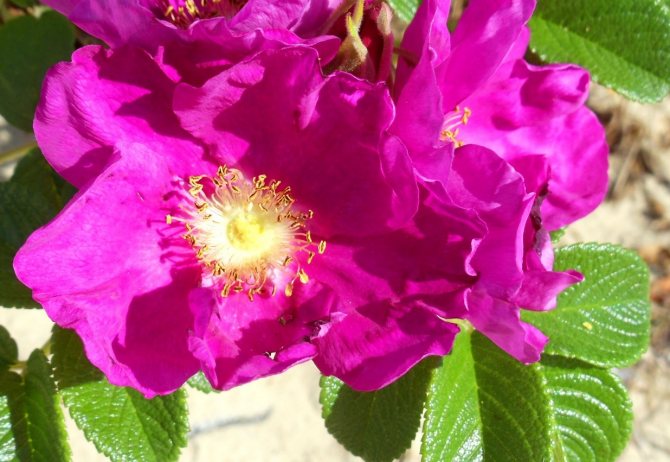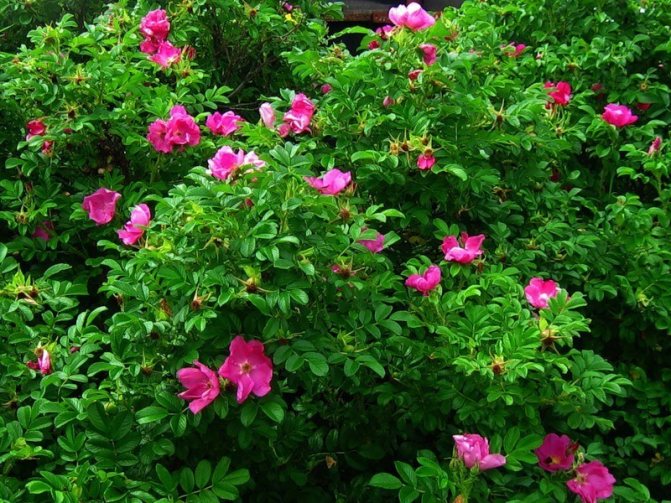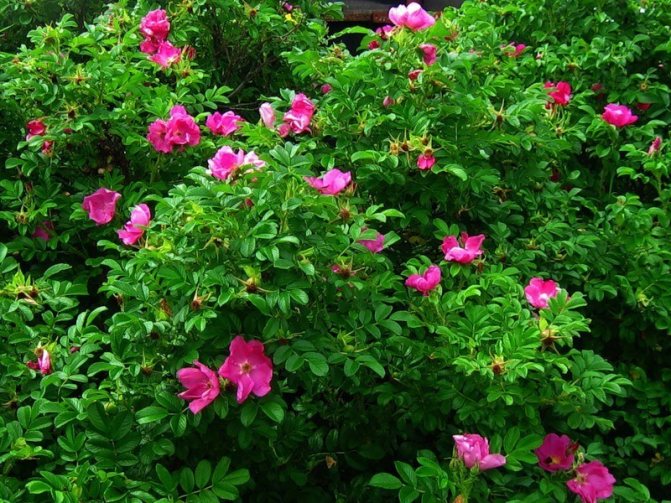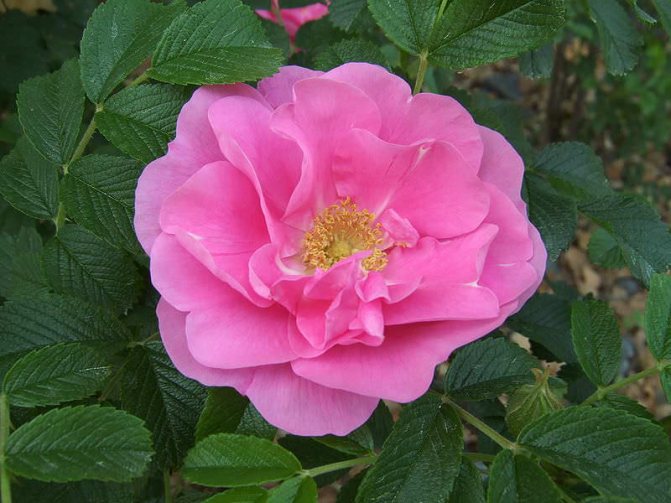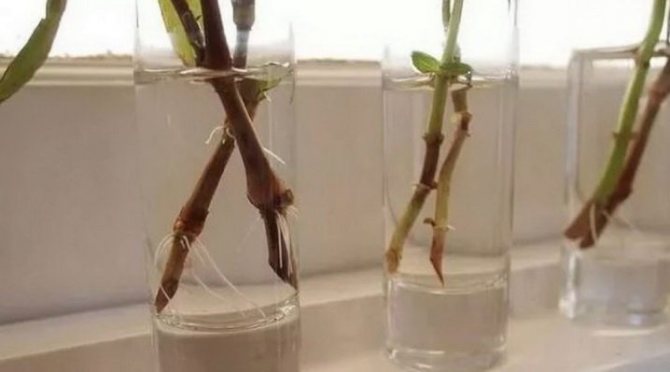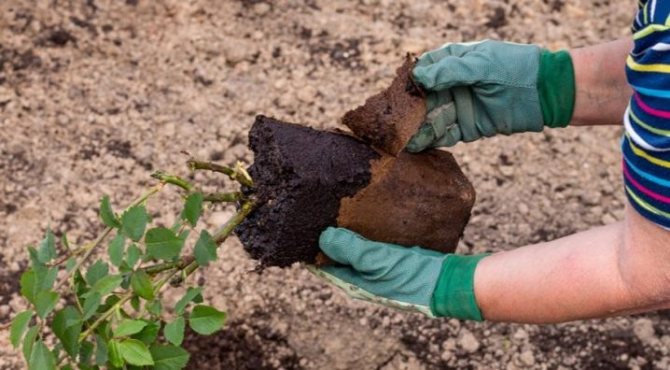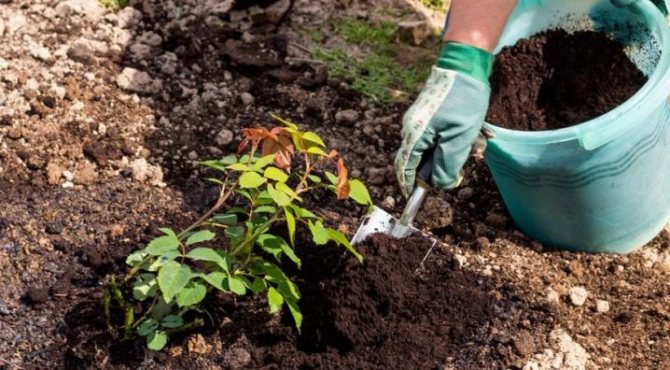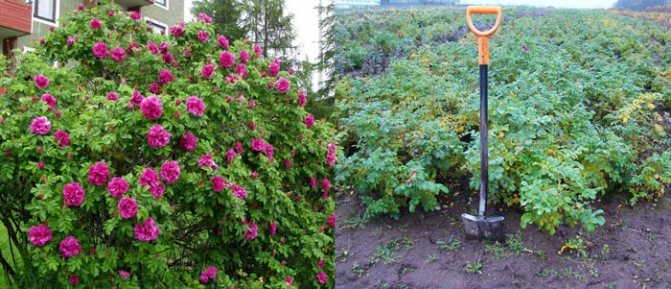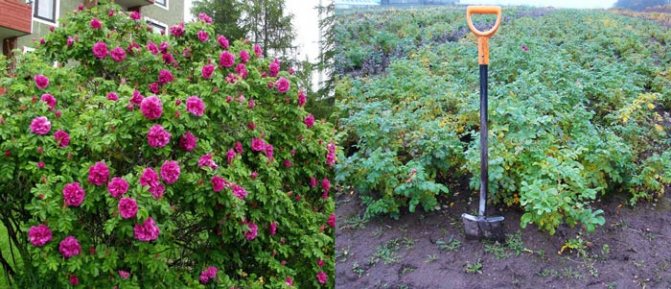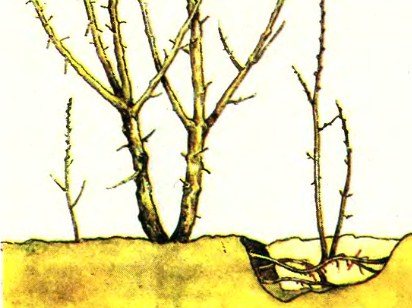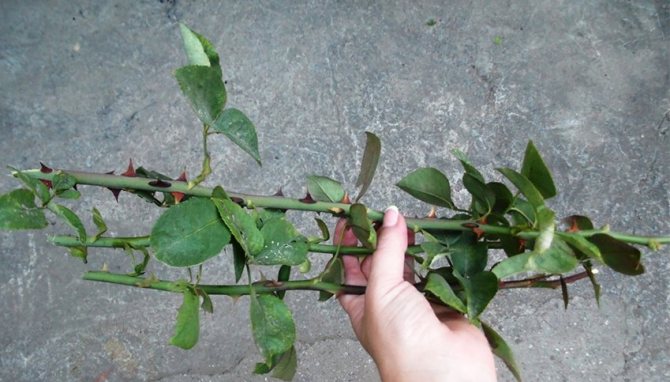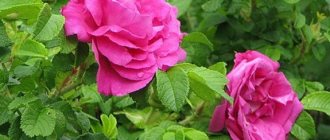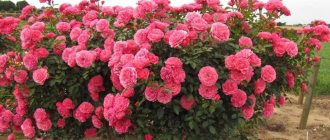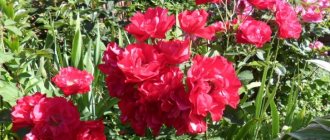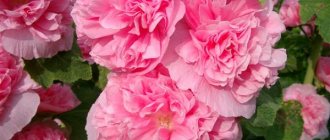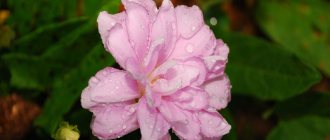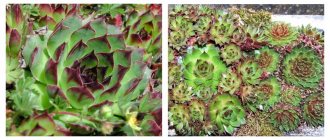Wrinkled rose is a very unusual and beautiful plant that attracts the eye with its amazing flowers and leaves. Other names for wrinkled roses are wrinkled rose hips, rugosa rose. Latin names: Rosa rugosa, Hybrid Rugosa (abbreviated HRg). In its natural environment, wrinkled rose is found in the Far East, North China, Korea. But Japan is considered the homeland. There are two main varieties of rugosa rose - the first blooms white, and the second is easily recognizable by its dark pink, crimson or red flowers.
Russian breeders (in particular Michurin and Regel) noticed this flower in the late 19th and early 20th century. Since then, numerous hybridization experiments have begun. The most successful specimens to this day are included in the best collections in the world and take prizes at international exhibitions. It is difficult to find exclusive varieties in nurseries, only a few are presented for sale.
Description of the plant
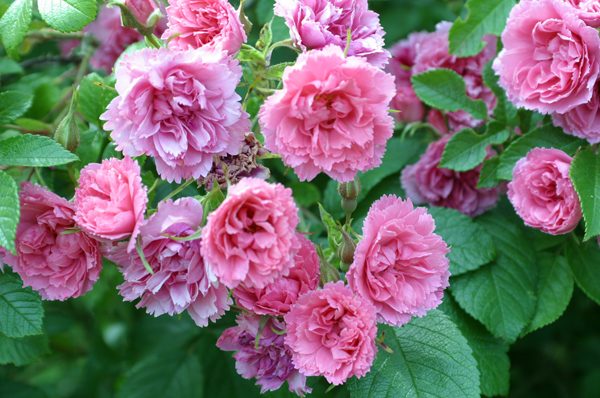
Wrinkled rose or rose hip, rugosa is the name of the same plant, which belongs to the Pink family. In the wild, it grows in North China, Japan, the Far East. Most often, this type of rose can be found on the sea coasts, coastal meadows. Often found in nature reserves, nature conservation areas.
Externally, the plant is a sprawling shrub up to 2.5 meters high. The leaves are distinguished by a wrinkled structure, gray-green pubescence below the leaf blade. Their length can reach up to 22 cm in length. Flowering is possible on both young and last year's shoots, on which numerous thorns are located, bent down.
Flowers are single or collected in inflorescences of 3-8 pieces. Fragrant buds are very large, colored in various shades depending on the variety. Abundant flowering, can last all summer, starting in June. Some hybrids can bloom twice in one season. At the end of summer, large orange-red fruits with a diameter of up to 2.5 cm are formed. The wrinkled rose is hardy, therefore it is often found in areas with a cold climate.
How is rose wrinkled used
The plant is used not only for decorative purposes. It is also grown for flowers and fruits. The petals can be used to make aromatic tea and jam, as well as refreshing eau de toilette for the face.
Compotes are cooked from berries, decoctions and infusions are prepared for the treatment of certain diseases. Like rose hips, rugose contains ascorbic acid, albeit in smaller amounts. Therefore, the fruits are used for the treatment and prevention of vitamin deficiencies, used in dietary therapeutic nutrition.
Any of the varieties of wrinkled roses is worth it to decorate a garden or flower bed near the house. However, you should be careful with people prone to allergic reactions to odors and pollen.
The cost of seedlings depends on the type of plant and the region. For example, in the Moscow region, the price fluctuates around 500-700 rubles apiece. In the southern regions (Rostov Region, Krasnodar Territory), the cost is lower - about 300 rubles.
Types, varieties
Rosa rugoza is the only species in its group, but thanks to the efforts of breeders, many varieties have been bred. They differ in the color and texture of the buds, the size of the bush, and the peculiarity of cultivation.Below are the most popular varieties for cultivation in Russia.
Grootendorst
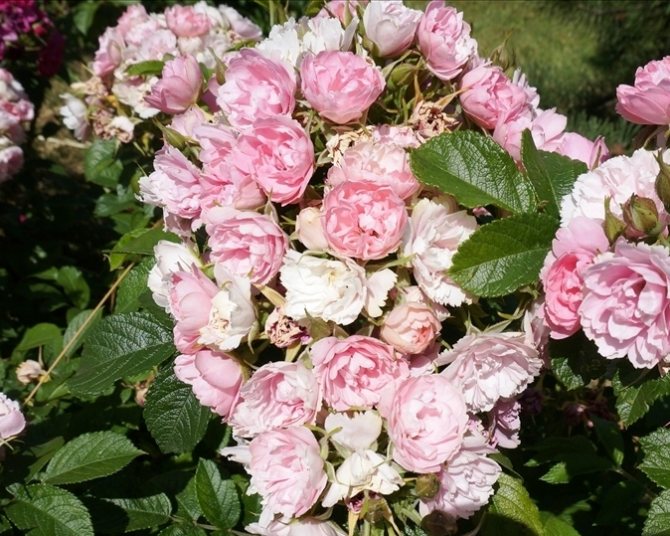

This is a large varietal group, represented by several varieties of park roses. Bred by a Belgian breeder in a nursery in 1918, later varieties were obtained that differ in the color of the buds. The height of the bush does not exceed 1.5 m, the plant is always erect. The leaves are typical of all wrinkled roses.
Of interest is the shape of the flowers, after which the variety is often called the carnation rose. Flowers are solitary, but more often they are collected in small carnation inflorescences of 5-20 pieces. The color varies from particular variety, with pink, white and crimson petals being more common. Rosa Grootendorst tolerates winter well, but in severe frosts, shelter is required.
Alba
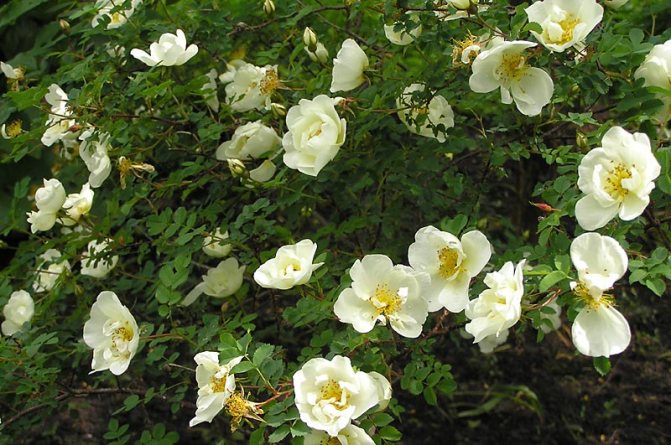

A hybrid form of European selection. The variety is represented by an upright bush up to 2 m high. Flowering is possible only once per season, lasts up to 30 days. The bush does not form fruit. The flowers are large, growing up to 5-8 cm in diameter. The color of the petals is white or pink-white. Differs in frost resistance, disease and pest resistance.
Hansa
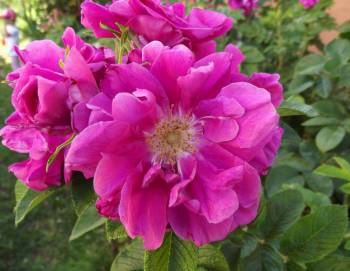

A popular variety often used for hedging. It is a short shrub that grows up to 2 m in height. Elongated buds, terry petals, painted in lilac color with a golden center. Flowering is possible all summer, right up to the frost. The fruits resemble small red-orange tomatoes.
Queen of the North
Differs in high frost resistance and resistance, as well as a fast growth rate of the bush. The plant can grow up to 2 m in height, but in colder regions the rose is usually more compact. Flowering lasts almost the entire season from June to early September. The flowers are large, growing up to 12 cm in diameter. The color of the double petals is pink or white-pink. The fruits contain a large number of useful elements, due to which they can be used to make jams and preserves.
Rubra
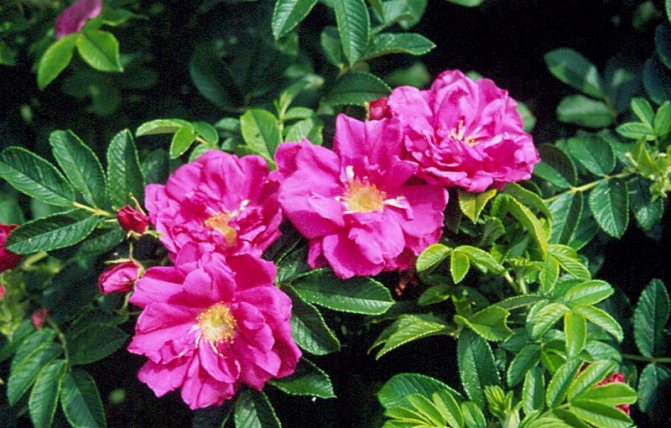

The rose of this variety is a large, spreading shrub that grows up to 2.5 m. Flowering is possible all summer, in favorable conditions there is a chance of re-bud formation. The flowers are large, there are specimens up to 12 cm in diameter. The petals can be painted in a variety of shades of pink. At the end of summer, large orange-red fruits are formed. The variety is distinguished by its unpretentiousness, ease of care. Often used to create a hedge, planting in a mixborder.
Diseases, pests and methods of dealing with them
One of the key advantages of the culture is its high immunity to diseases and excellent resistance to pest infestations. With proper care, the plant practically does not get sick. Otherwise, powdery mildew and rust may develop. With an excess of moisture in the soil, rotting of the culture begins. For the treatment of ornamental shrubs, fungicides are used, in particular, "Fundazol", "Magnicur Star", "Topsin-M".
Wrinkled rose hips are occasionally affected by leaf rollers, sawflies and spider mites. Spraying the bush with insecticidal preparations will help to quickly remove insects. For example, you can use "Aktara", "Decis Profi", "Conifor Maxi", "Calypso", etc.
Choice of place and conditions of detention
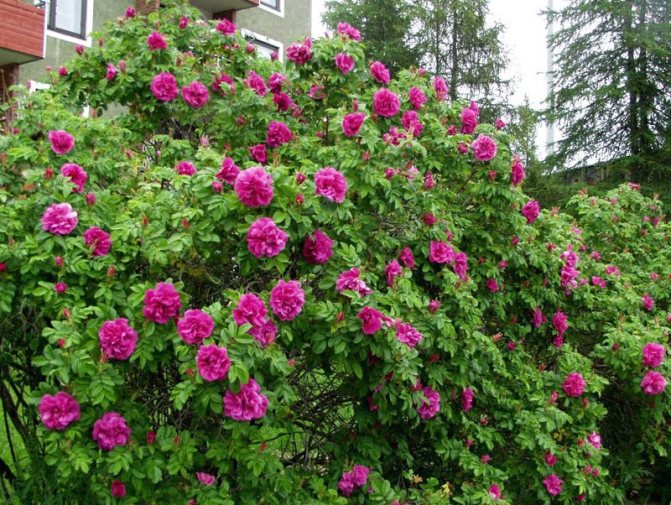

In general, the wrinkled rose differs from other members of the family in its unpretentiousness and adaptability to external conditions. The plant is often planted to create a hedge, so in order to achieve active growth and abundant flowering, you should correctly approach the choice of a place for growing.
Lighting and location
Rose rugosa is a light-loving plant. For planting, it is best to choose a well-lit area with protection from the wind. The optimal solution is a southern slope or a flat area next to a building or a fence.Often, a wrinkled rose is planted as part of a multi-species mixborder, in which case it is not recommended to place the plant under the shade of large trees. Subject to the rules of care, the shrub is characterized by active growth, so you need to correctly plan the place, especially when creating a hedge.
Temperature
Almost all varieties of wrinkled rose hips are unpretentious to temperature conditions. The plant grows best in the 16-22 ° C range, but can even tolerate severe frosts down to -40 ° C. It is recommended to protect young plants in the first two years of life from sudden changes in temperature, for example, with the threat of night frosts in spring and autumn.
In addition, when growing in the northern regions, it is recommended to cover the bush for the winter, since sudden changes in temperature can lead to the death of the bush, young shoots. In the southern and central regions of Russia, there is no need to protect a wrinkled rose.
Air and humidity
The plant prefers moderate humidity, with an increase in the level of moisture in the soil, infectious diseases of the root system may develop. Therefore, in the rainy season, it is recommended to reduce the amount of watering; additional procedures, for example, spraying are not carried out.
A wrinkled rose does not tolerate drafts well, so you need to competently approach the choice of a place for planting. For adult bushes, the installation of a support is required to avoid breakage of branches, stem.
Priming
It is advisable to plant a garden rose of this group in a fertile and well-aerated soil. It is desirable that the substrate retains water well, but does not accumulate it in large quantities. The best option is sandy loam or loamy areas with a neutral acidity level. When growing in a dense substrate, it is advisable to add river sand before planting at the rate of 10 kg per 1 m2 to enhance looseness and aeration.
Planting seedlings in the open field
Even beginners and inexperienced growers can handle the planting of a wrinkled rose. Entering the category of completely undemanding to the soil and place of growth of plants, it also easily tolerates a sharp change in temperature and drought, but in order to obtain the most beautiful and rich color of flowers, it is better to take care of creating the most optimal conditions for its growth and development.
Seat selection
A wrinkled rose is an undemanding plant, but it feels most comfortable in bright sunlight, so a well-lit and wind-protected slope of the south or west side is suitable for planting a shrub.
The moisture content of the soil for the Rugosa rose is also not a decisive factor, but for the fastest possible growth and development, it is better to use a substrate with a low acidity level.
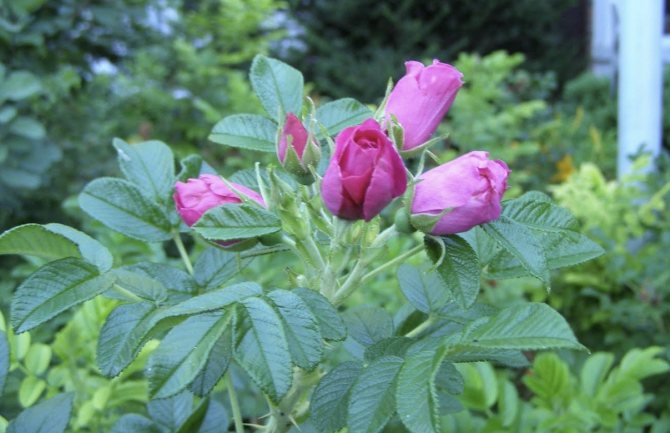

When planting shrubs in alkaline soil, it will be necessary to regularly apply mineral fertilizers, since such a soil composition will not be able to fully nourish the plant.
Important! Despite the fact that the leaves of Rugosa are quite dense and tough, they are very easy to burn, therefore, care for the rose with the help of chemicals is carried out with extreme caution.
Scheme and depth
The most suitable time for planting a plant is considered early spring, before bud break, but planting is also permissible in autumn, if the characteristics of the variety allow. Depending on the purpose of the procedure, the distance between the seedlings may be different:
- if we are talking about creating a hedge, in this case it is necessary to make an interval of at least 70 cm;
- if the bush is planned to be planted alone, it is recommended to build a vertical fence, for example, with sheets of roofing iron, keeping a distance of 2 m between plantings;
- group plantings of Rugosa roses with other plants require a mandatory distance of 1.5 m.
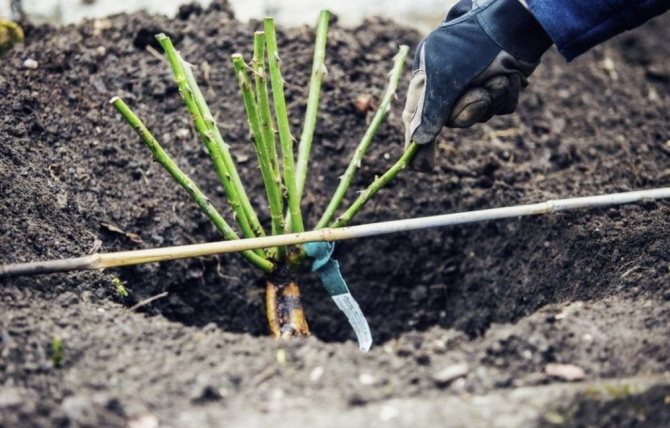

The depth of the hole is usually 40-50 cm.Before the planting process itself, the soil will need to be well fertilized by adding a bucket of peat or humus to one hole. To avoid drying out, immediately after planting the seedlings, the substrate is abundantly watered and mulched, and the shoots must be shortened by one third. After carrying out all the necessary procedures, the seedlings will need to be shaded from the sun for the first few weeks of rooting in order to protect them from burns on the leaves.
You will probably be interested in learning how to grow roses from seeds.
Preparing for landing
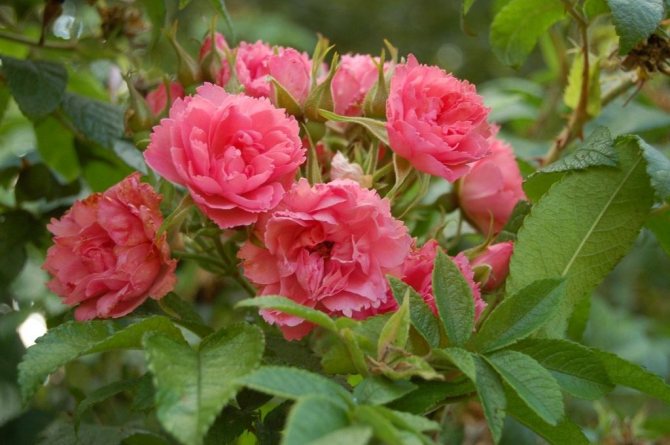

Before planting, you need to prepare not only the seedlings, but also the soil. To do this, 2-3 days before the start of work, you should qualitatively dig up the area to the depth of the shovel bayonet. Fertilizers must be applied. Plants respond well to organic matter, so the introduction of these compounds is mandatory. For example, peat or humus is used at the rate of 8-10 kg per meter. In addition, it is recommended to add inorganic compounds - 10 g of superphosphate, 50 g of potassium salt per 1 m2.
Seedlings should be inspected for deformations, damage to the stem and roots. The root system should be healthy and slightly hydrated. A few hours before planting, you need to soak the seedlings in a growth stimulant solution, for example, Kornevin or Epine. It is advisable to carry out the procedure itself in the morning or in the afternoon, so that during the first half of the day the roots adapt to the temperature of the soil.
Advantages and disadvantages of Rugosa rose
The main advantage of this species is its excellent plant productivity and regular yield. So, for example, the fruits begin to ripen at the end of August and this process lasts for almost three weeks.
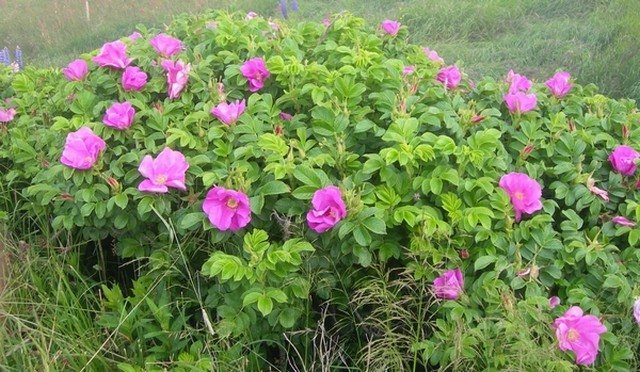

Roses require careful maintenance
But, of course, there are also downsides. For example, a large amount of growth quickly forms on a bush, and it also has a low drought tolerance.
Planting process
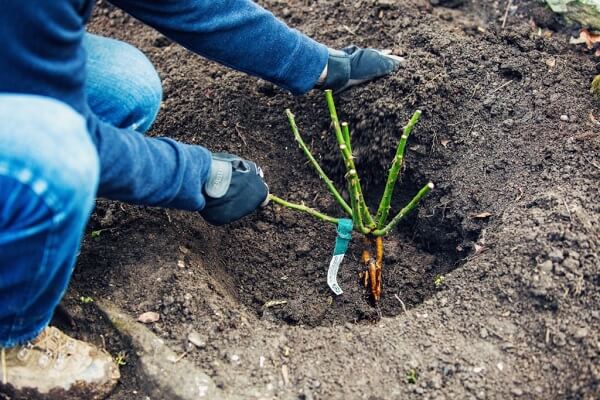

It is permissible to plant wrinkled roses both in autumn and in spring until new buds appear. The optimum length between plants is 1.5 meters. To form a hedge, planting density should be observed at the rate of 50-100 cm between plants, 50-80 cm between rows. Seedlings are planted in individual holes, taking care not to damage the root system. During planting, you need to add a little wood ash to the bottom of the hole to prevent fungal diseases.
Immediately after planting roses, they must be cut to 1/3 of the length of the shoots, watered abundantly with water and mulched. Already at this stage, it is worth installing supports in order to reduce the harmful effects of the wind. When planting in autumn, young plants are covered with spruce branches or agrofibre to avoid hypothermia.
Biological features
"Rugoza" –
shrub that grows up to two meters high. Its branches can have various shapes, and lignified old shoots lose their foliage and turn brown. Rose bushes, depending on the species, can be creeping or liana-like, rising significantly above the ground.
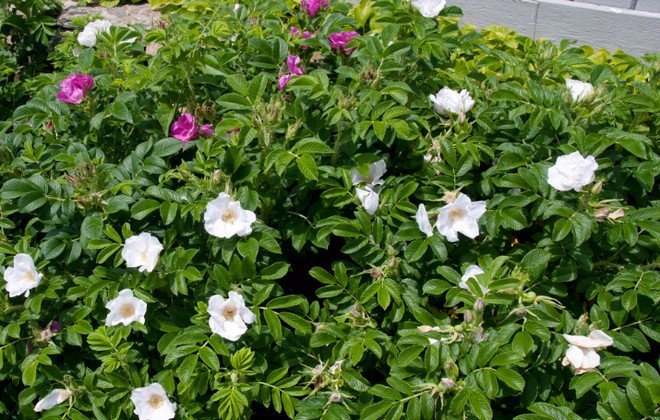

The shoots of this shrub are densely covered with small and large needle-shaped or crescent-shaped thorns. The foliage of the rose bush is characterized by a bright green color with a characteristic shine.
The leaves are rounded-elliptical with jagged edges. They are collected in constellations of seven leaves.
You will also be interested to learn about bush roses, climbing, ground cover.
The rose bush begins to bloom in May or early June. Flowers have a wide variety of colors: white, pale pink, yellow, bright red. Over time, the number of flowers decreases, but the rose continues to bloom until frost.
The homeland of this shrub is China and Eastern Siberia, where it loves coastal areas and rather harsh natural conditions.
Did you know? Rosehips are the toughest plants that have stood the test of centuries. On the territory of the Hildesheim Cathedral, the dog rose grows, the age of which, according to scientists, is 400-1000 years old. And in g.Toomstone grows a specimen marked in the Guinness Book of Records as the oldest rose hip - since 1885.
The wrinkled rose is so hardy that it can easily tolerate saline soils, drought and harsh winters. In addition, this plant does not need special care, and the lack of fertilizers will not affect it.
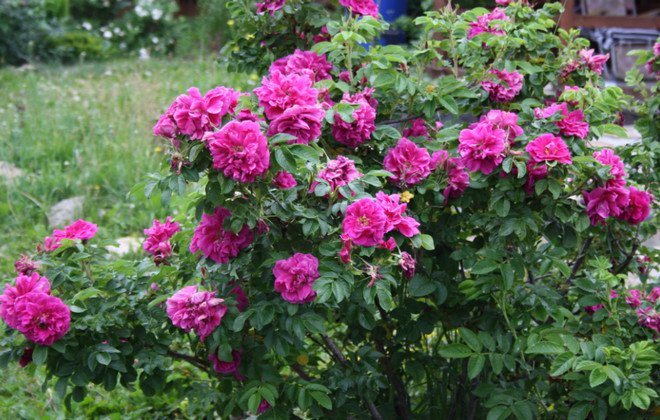

Decorativeness is inherent both in the original species and in all varieties that are derived from it. All hybrids retained their original qualities and a pleasant intense aroma.
Rules for care and cultivation in the garden
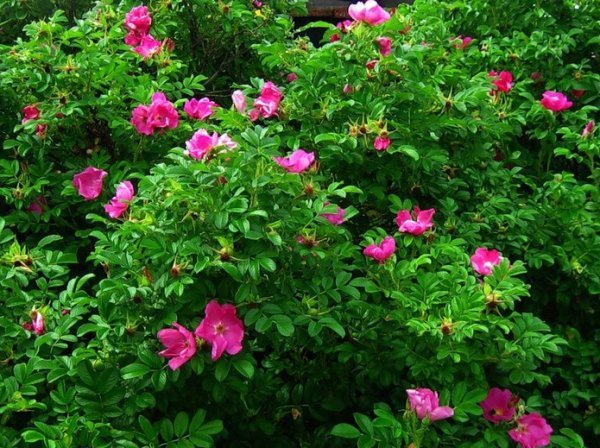

Wrinkled roses, when grown in a garden, are very unpretentious to care for. They do not need abundant watering, fertilizers need to be applied less often than for other flowering plants. Consider the most important points in caring for a rugosa.
Watering
Like other members of the Pink family, the wrinkled rosehip is a moisture-loving plant. At the same time, it is important to observe the irrigation regime and the specifics of water application. The shrub is watered only at the root, avoiding the ingress of liquid on the buds and leaf blades. During the active growing season, the plant is watered no more than twice a week at the rate of 10-12 liters per bush. In the rainy season, watering should be reduced to a minimum or stopped altogether. The rose is completely stopped from watering, starting from the beginning of September, so as not to affect the formation of new shoots.
Top dressing
Roses respond best to organic matter, so at least twice a season it is worth adding humus or mullein solution under the root. The procedure is carried out in the spring and autumn after scheduled pruning. Before the beginning of the growing season, the plant needs magnesium and iron, therefore it is recommended to use complex formulations containing all the necessary elements.
During the season, liquid multi-component fertilizers are used as top dressing. The procedure is best done immediately after the next watering. If growth and budding are slowed down, you can use special compositions for garden roses, which can be easily found in any specialized store.
Loosening, mulching
The loosening procedure is carried out only in the first three years of plant growth, when the roots of the bush are actively forming. Loosening is carried out 2-3 times per season, starting in early spring. During this, you need to very carefully process the soil along the entire diameter of the bush, trying not to damage the root system.
Mulching helps to avoid active growth of weeds, improve the process of water retention on the upper soil layer. It is best to use sawdust or dry foliage as mulch; the procedure is carried out up to two times per season after pruning, which simplifies access to the bottom of the bush.
Pinching, pinching, pruning
Bush pruning is an essential part of working with wrinkled garden roses. The first formation is carried out no earlier than 2 years from the moment of planting, it is only of a sanitary nature. As a rule, pruning is carried out at the end of April before the formation of young shoots.
It is impossible to completely shorten all parts of the plant; only deformed, diseased and old branches need to be removed. It is advisable to cut the shoots to a length of up to 6 growth buds so as not to disrupt the flowering process. For rejuvenation, complete shaping is carried out, removing all parts of the bush to a length of 10-15 cm from the top layer of the earth.
Wrinkled rose hips respond well to pruning, so an annual decorative shaping is used to create a hedge. For this, the bush is given the necessary shape, leaving part of the young and old branches.
Transfer
Like other types of garden roses, rugosa can live in one place for up to 20 years. It is necessary to transplant the plant in case of infection of the bush, reducing the intensity of flowering and growth. The procedure is carried out only in the fall, immediately after the complete end of flowering and fruit formation.
First, the plant must be cut almost to the very root, and then, together with a lump of earth, transplanted into a previously prepared area. Immediately after this, you need to apply organic fertilizer in liquid form, water the soil abundantly and provide shelter for the winter.
Crown formation
Pruning a bush is a mandatory and necessary moment in caring for a wrinkled rose. They begin to cut the shrub in the third year after planting. All weak shoots are removed, branches lying on the ground, as well as root suckers that are located near the bush itself. Only five well-developed, strong shoots are left, the branches are cut to a height of 15-18 cm.
Pinching will help stimulate the growth of side branches and fruiting. It is carried out when the shoots reach 70 cm in height. Further, you need to annually cut off those branches that bear little fruit, dry out or get sick. In order for the bush to bloom luxuriantly and bear fruit well, it is important to control the number of branches in it. There should be no more than 20 of them in a plant of 6-7 years old.
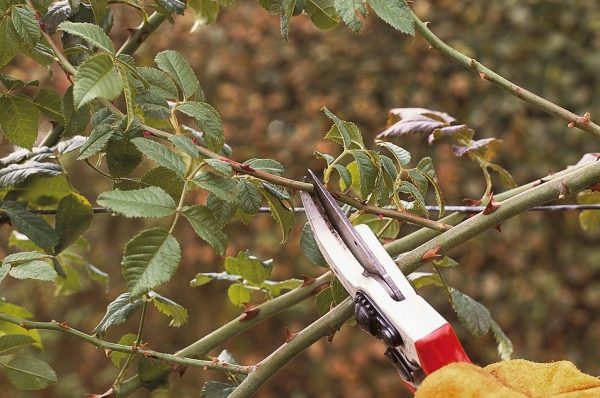

Timely pruning stimulates the growth of young shoots and abundant flowering.
Wintering
Wrinkled roses tolerate even severe frosts best, so they are often planted as an ornamental garden culture in cold regions. Additional shelter for the winter is required only when growing shrubs in the north, for plants up to 3 years of growth, as well as after the next transplant to a new place.
During preparation for winter, all the buds must be removed from the plant and the fallen leaves and fruits must be removed, and then the soil must be sprinkled with high quality to a depth of 20 cm.It is very important to prune and mulch the near-stem part of the shrub. The upper part of the plant is tightly tied to a support, wrapped in craft paper or cloth, and then covered with spruce branches. You can remove the shelter in the spring, when there is no likelihood of severe night frosts.
Transplant and breeding methods
It is necessary to transplant a shrub only if it becomes infected or when the number of buds forming is reduced. This event is carried out at the end of the stage of fruit formation. The branches of the wild rose are cut to the very base. The plant is dug up together with a lump of earth and moved to a new hole. Then the culture is fed with liquid organic fertilizers, mulched and covered for the winter.
Rugosa rose is propagated mainly by cuttings. In early June, green cuttings are harvested. How to root rose cuttings correctly is shown in the diagram below:
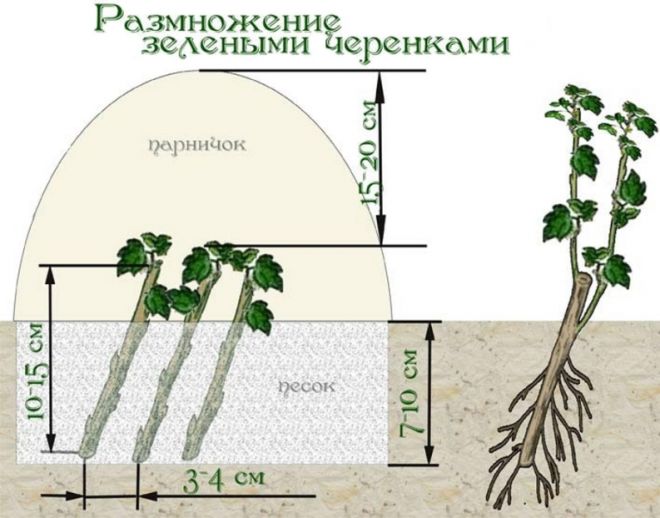

Rooting rules for green cuttings
The culture can also be propagated by root shoots. Shoots with a length of 30-40 cm are separated from the mother bush and planted in separate containers or harvested at the site of the hole. From above, they are spudded with humus and left to root.
Nuances and tips for growing
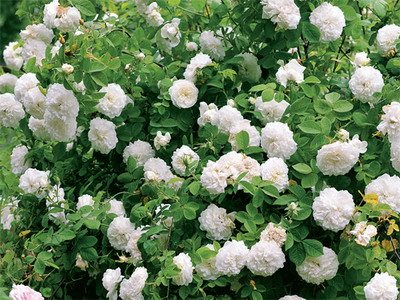

Wrinkled roses are the most successful option for landscaping a site in regions with unfavorable climatic conditions. There are a number of cultivation subtleties that will make it easier to work with a shrub:
- Rugosa rose has a high resistance to diseases and pests, but as a preventive measure, it is recommended to treat the planting with insecticides and fungicides at least once a season. It is best to use the most effective complex chemical formulations;
- to increase the volume of planting, a wrinkled rose can not only be propagated by cuttings, but also used independently collected fruit seeds. They have a high level of germination, are stored for a long time;
- if the growth rate of the bush has significantly decreased, and the flowering is less abundant, then it is recommended to carry out sanitary pruning or transplant the plant to a new place;
- when buying planting material, you should pay attention to the photo and annotation on the package. Often less decorative rosehip varieties are sold under wrinkled rose varieties;
- large and healthy fruits can be used to create blanks, jams and even medicinal infusions.
The wrinkled rose is a unique ornamental plant. It has high resistance, immunity and rapid growth. Due to its attractive appearance, the shrub is often used in landscape design to create multi-species compositions, create a hedge. The plant can stay in one place for a long time, please with abundant flowering, even with little care.
Application in landscape design
A huge selection of different varieties of Rugosa rose allows it to be used very profitably in landscape design, especially given its ability to cleanse the surrounding air from pollution. The shrub found the most active use in creating an impassable hedge, which additionally serves to protect the site from uninvited guests, and the formation of fruits after flowering makes it possible to enjoy such a hedge all year round, without making any special efforts to maintain it.
Rugosa roses are planted as independent plants. Also, the area of application of the wrinkled rose as a decoration for various vacation spots is very wide, and Rugosa is also a favorite of landscape designers who prefer to create numerous ethno compositions from it, combining it with other plants.
The most beneficial and interesting are combinations of Rugosa rose with juniper, any coniferous or deciduous tree, spirea and even stones - such compositions are called "rockeries". In addition to decorative purposes, the shrub also serves as an excellent ecological and natural barrier, as it reliably strengthens banks, ravines and purifies the air in an industrial area.
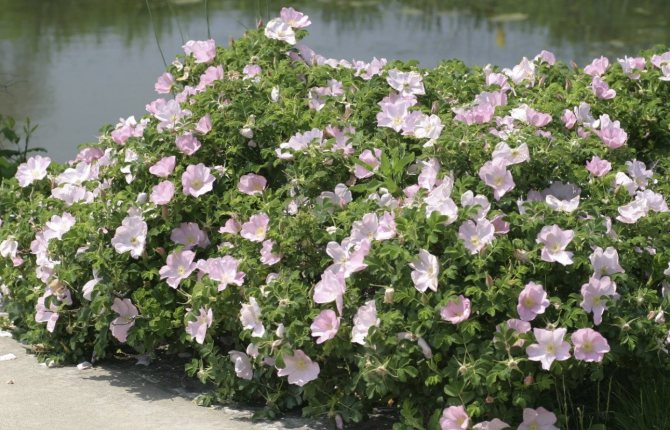

Propagate by root cuttings and cuttings
| 1. Root shoots Process:
You can cover the growth with a hill of humus (30 cm) and water it during the season to form adventitious roots. Separate from the mother plant next season, leaving 15 cm aboveground |
| 2. Cuttings Process:
Cutting is the most popular and easiest way to propagate the Rugosa rose. |
About old roses on video
Those who are fond of roses could not help but notice that the assortment of varieties of roses in nurseries today is completely different than a few years ago. New varieties appear regularly, but where do the old ones go? In the video below, there is a story about roses that are rare today and have already become a kind of garden "antiques".
Abelzieds (Abeljzieds)
Abelzieds (Abelzieds, Apple blossom) is a variety of park roses, a hybrid of Rugosa, created in the Botanical Garden of the Academy of Sciences of the Latvian SSR (currently Salaspils Botanical Garden).
The bush is vertical, spreading, prickly, reaching up to 1.5 meters in height, and up to 2 meters in width.
The foliage is dense, light green, with a glossy sheen.
Buds are small, elongated with sharp tops. The flowers are small (5-7 cm in diameter), semi-double (7-10 petals), cupped. Petals with a pale pink color around the edges and a white base, they twist coquettishly, which gives the charm of a rather simple flower. In the center of the bud, a bunch of golden stamens is clearly visible.With age, the flowers fade to almost white, and the stamens, on the contrary, darken a little. The aroma is pleasant, but weak. Flowers appear in inflorescences of 5-15 buds.
Flowering is continuous, abundant, long-lasting.
The variety is distinguished by exceptional frost resistance and very good disease resistance.
Suitable for creating a hedge. Can be grown in groups or single spreading bushes.
- Seedlings of roses with a closed root system: from the moment of grafting, the rootstock is immersed in a peat substrate and wrapped in a film "tube".
- Rootstock: Rosa canina "Schmidt's Ideal" (seedling of Kanin's dog-rose "Ideal Schmidt"), which provides increased winter hardiness, frost resistance, drought resistance and durability, and at the same time does not produce abundant rose hips.
- You can buy seedlings of roses Abelzieds (Abelzieds) by clicking the "Add to cart" button and placing an order.
Propagation of a rose by cuttings
Under natural conditions, the wrinkled rose propagates by seeds. Cultivated species are bred by vegetative methods: planting children, dividing a bush and grafting.
Budding is carried out in early spring or early autumn.
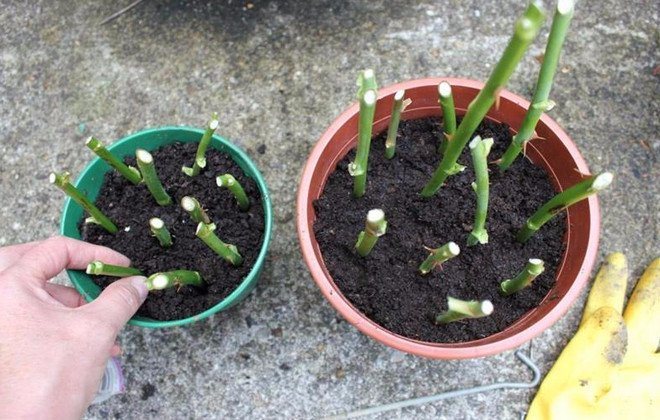

In winter, all rootstocks need quality shelter. After the establishment of warm weather, the seedlings are uncooked and pruned.
If propagation is carried out by cuttings, then cuttings cut in the fall are stored until spring in a container with wet sand in a room where the temperature is maintained at + 4-5 ° C.
Why Roses Don't Bloom
- Weakened seedling. Such a plant will take root for a long time and can bloom only for the next season.
- The plant is too young. Before blooming, the plant must form a root system and grow a crown. Even if individual buds appear, they must be removed so that flowering does not take away strength.
- Inappropriate landing site. Rosa Rugosa loves bright lighting, it can also grow in the shade, but flowering will be scarce.
- The plant is too old. Rosehip should be periodically rejuvenated by cutting out all old shoots and leaving up to 5 young, well-formed branches, cut into 2 - 4 buds.
- Lack or excess of moisture. With a lack of moisture, the flowers will be small and small, and prolonged excessive moisture can completely ruin the plant.
- The rose is blown by the north winds. Rugosa does not like this very much.
- A plant weakened by diseases and pests. In order for the rose to bloom profusely, engage in the prevention and timely treatment of the diseases that have arisen.
- Lack or excess of nutrients. Feed the rose strictly according to the instructions on the package and in accordance with the gardening calendar.
Nuances
Many amateurs are wondering if there are any other nuances in breeding wrinkled roses and are they susceptible to disease?
The plant is resistant to various diseases, this is one of the main facts that made it so popular in many countries with different climates. This is what makes it a worthy competitor to garden roses, many of which are undoubtedly much more spectacular, but it is not always possible to see them as beautiful as they promise in catalogs, and all because of susceptibility to disease.
Important! Despite its resistance to diseases, wrinkled rose is susceptible to various chemicals (used in some fertilizers), falling on a leaf or petal, such agents can provoke a severe burn of the plant.
Breeding tricks
The plant can be propagated by seeds. To do this, you need to collect them at the end of autumn. You can sow them immediately in the fall or next year in the spring.
When propagating by cuttings, many make a big mistake, first placing the rhizomes in water, their roots are fragile and being in a liquid contributes to their destruction and, as a result, the seedlings do not survive.
Features of rose care
Planting a rose is possible both with seeds and vegetatively.Florists advise replanting cuttings or root processes of a rose. Cuts of green or woody stems take root very well.
- no support or tying required;
- requires a minimum amount of preventive spraying;
- in the spring, cutting off all broken, weak and very old processes is required;
- in the period from spring to summer, it is required to feed the rose with completely mineral fertilizers or mullein;
- after the first flowering, it is advisable to feed the plant with a solution made on a mullein, and in the fall you need to use phosphorus-potassium fertilizers.
Rose bushes hibernate mainly in the open air, remarkably enduring both frosts down to minus forty and the heat.
But do not forget that wrinkled roses often develop chlorosis, therefore fertilizers should be complete.
Thus, growing this rose is a great pleasure for any gardener.
Breeding flowers
Like any garden rose, rugose and its hybrids propagate by cuttings. For procreation, strong stems with several buds are chosen. Flower cultivation is also possible with seeds. They are harvested from ripe fruits. The grains remain viable for several years. Every gardener chooses for himself a convenient way of growing these flowers.
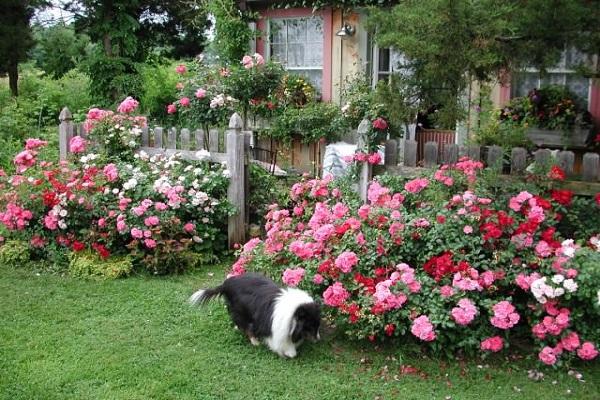

Where can one buy
You can buy a wrinkled rose seedling at a gardener's specialty store or order it online. In recent years, various online shops with garden plants have been practicing cash on delivery delivery of plants to their consumers.
You can buy a wrinkled rose in such nurseries.
| Rose Alba | sadovod.center | 330 RUB |
| Rosa Rubra | sadovod.center | 330 RUB |
| Rugosa white (pink) | From 300 rubles. | |
| Rubra | From 250 rubles. | |
| Alba | From 250 rubles. |
The final prices for seedlings can be obtained from a consultant of an online store or a plant nursery, since the cost depends on the height of the plant.
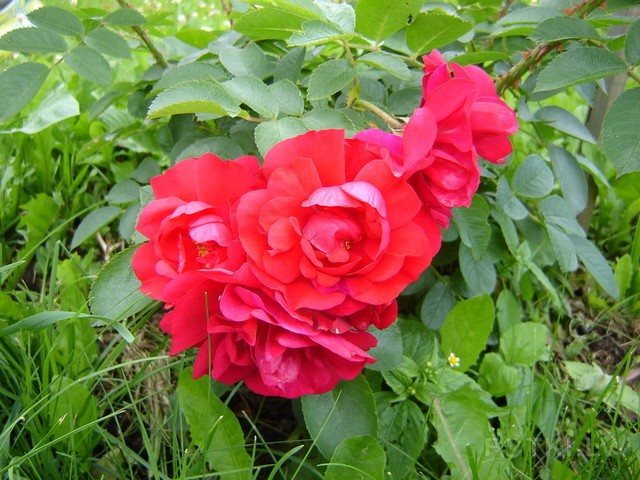

Rubra wrinkled rose is not only a beautiful plant, but also useful. The fruits of the shrub are rich in vitamins C, E, B, P, in addition, they contain such useful substances: potassium, magnesium, phosphorus. The fruits of wrinkled rose hips are eaten raw or ready-made: jam, jam, juice or various medicinal infusions. Often, decoctions of rosehip berries are prescribed by doctors. Based on this, we conclude that a flowering bush will give not only beauty to your garden, but also health.
Gardeners reviews
Lada-Dem
Marina Anatolyevna, I can share the seeds of "Rosa rugosa rubra", I see you are from Moscow. I live near the MCC Koptevo (Golovinsky district). We had thickets of these roses near the ponds, they bloom until the very frost, the aroma is amazing, like that of Blue Moon, only twice as rich.
Lsstep
Elena Vladimirovna, this is Rosa rugosa rubra. It multiplies very easily, especially by undergrowth: dug out, planted, watered - and forgot.
The best varieties and hybrids
Rose "Rugosa" has a huge number of varieties and hybrids, which are distinguished by a high level of decorativeness. Most of all, these shrubs are attracted by the incredible aroma of large double flowers. At the same time, the fruits of this plant are not only beautiful, but also useful, which allows them to be effectively used in folk medicine.
So, the most popular varieties:
- Grootendorst
... The first copy of this line was developed in 1918 by De Goy and named after his colleague F.J. Grootendorst. In the same year, the "mastermind" introduced her to his greenhouse for further selection. The source for this variety was the Rugosa Rubra rose, which was crossed with a little-known polyanthus species. Thanks to this selection, a charming specimen with bouquets containing 5-20 crimson-red weakly fragrant flowers of small diameter (3-4 cm) was obtained. The unusual clove-like shape and abundant flowering gave this variety a different name - "Nelkenrose" (carnation rose). In our area, this erect bush grows up to 1-1.5 meters. Leaves are glossy, dark green.The plant is winter-hardy, freezes only in severe frosts.


- Pink Grootendorst
". Pink version of Grootendorst variety. The most amazing specimen.
This pyramidal-spreading shrub grows up to 1.5 meters. It has wrinkled, shiny light green leaves.
Flowers - light pink, densely double, 3-4 cm in diameter. In inflorescences 5-15 flowers are collected, the petals of which have carved edges.
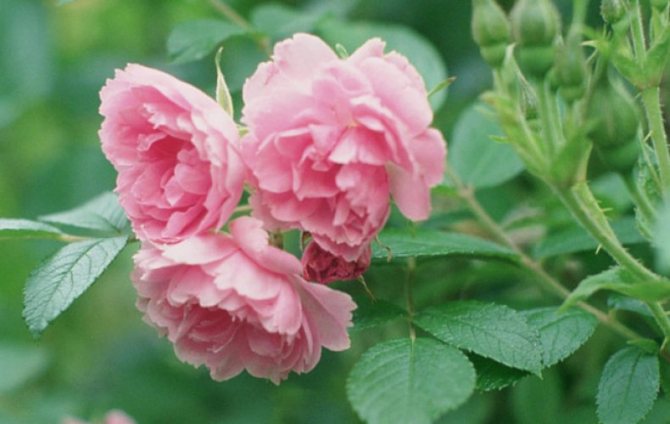

- Grootendorst Suprem.
Differs in dark crimson flowers.
- White Grootendorst.
Terry pure white version of the Rugosa rose.
- "Abelzieds"
... High (up to 2 meters) pyramidal shrub. Differs in cupped pale pink semi-double flowers.
- "Agnes"
... It is characterized by large creamy yellow double flowers.
- "Georges Quene"
... The flowers of this hybrid are large, cup-shaped, fragrant, dark red.
- Konrad Ferdinand Meyer
". It is characterized by double bright pink flowers with a silvery sheen.
- "My Hammarberg".
Low (up to 50 cm) shrub with large wrinkled leaves. It blooms in cupped, light purple-red flowers (about 9 cm in diameter).
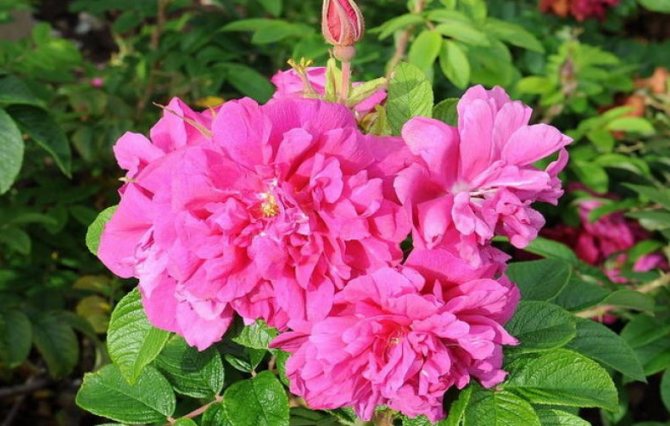

- "Rosere de L'3"
... Differs in cherry-red large (8-10 cm) double flowers.
- "Souvenir de Philemont Cochet".
Shrub with large white cupped flowers.
- "Queen of the North"
... It blooms with double red flowers. The most hardy variety of double roses.
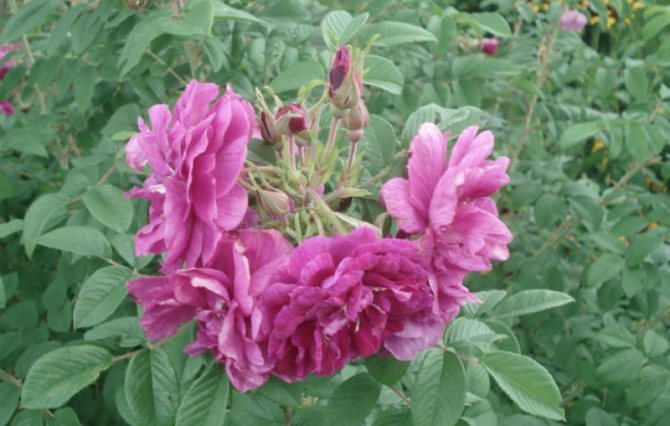

- "Hanza"
... Shrub with large reddish-purple flowers.
- "Alba"
... The leaves of this shrub in the fall change from light green to golden. It blooms profusely with white flowers with original golden stamens.
My Hammerberg
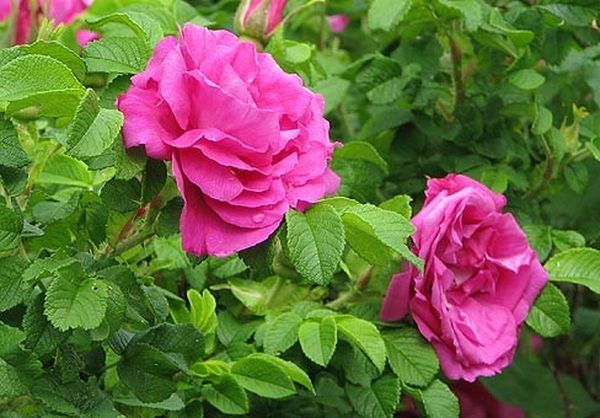

The rose is wrinkled with interesting violet-red red weak double flowers with yellow stamens. Cupped shape, diameter up to 9 cm; up to 17 petals in one flower. Brushes are composed of approximately 5 colors. The aroma is well expressed. Flowering is long and plentiful, lasts from June to September. Due to its high frost resistance, the variety can winter without additional shelter. In general, it belongs to light-loving varieties, but it also tolerates partial shade.
How to choose seedlings?
A seedling can be grafted or grown from a cuttings with an already formed root. When buying a plant, you should pay attention to the following signs and criteria:
- preference should be given to annual seedlings;
- a plant with open roots will easily survive moving and planting in a new place, the main thing is not to let the roots dry out, for which it is recommended to wrap the root system with a wet rag or plant in a bag with a small amount of water or wet earth;
- shoots of seedlings are smooth, without damage;
- it is not recommended to purchase seedlings with blossoming buds, such a plant is most difficult to adapt to a new place;
- seedlings sold in stores in packs can be weakened by long-term winter storage, their root system can be overdried.
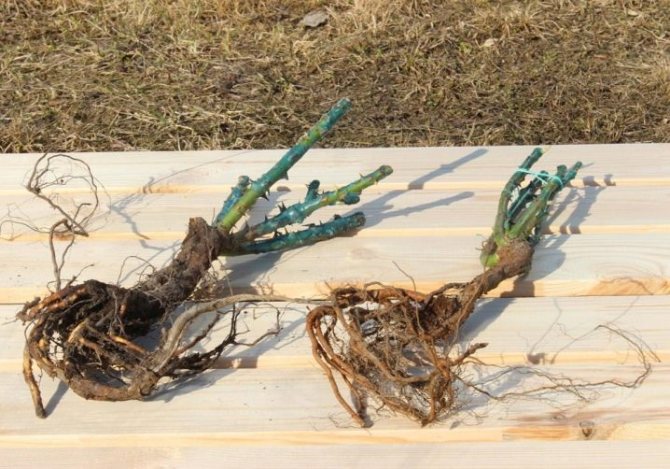

Things to Remember
- Variety: wrinkled rose (Rugosa rose).
- Genus: rose hips.
- Landing: sunny area, nutrient soil, drainage, watering, mulching, keeping the distance between seedlings.
- Care: weeding, loosening the soil, fertilizing, watering, pruning.
- Diseases and pests: powdery mildew, black spot, rust, rose aphid, rose sawfly, bronze.
- Why does not a rose bloom: too young or old plant, weakened seedling, diseases and pests, lack of light, improper watering, unbalanced feeding.
- Reproduction: root shoots, cuttings.
Pink Grootendorst
A pink variety of Grootendorst. The bush is pyramidal, spreading, up to 1.5 m in height. The combination of delicate pink flowers and light green leaves looks airy and romantic, and can add a special lightness to the note area.
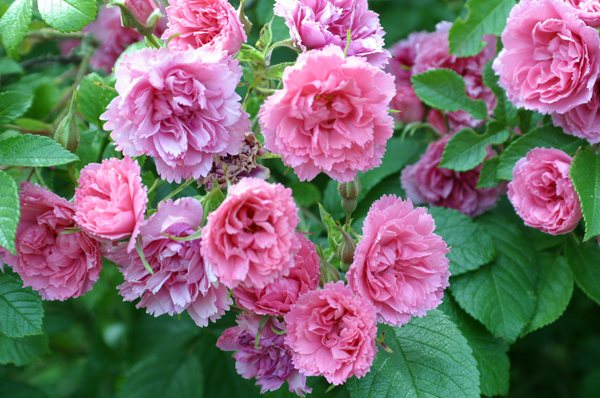

Flowers are the same shape and size as the main variety. They have 30-40 petals, brushes are formed of different sizes (from 5 to 15 colors).The wrinkled rose of this variety blooms magnificently and perfectly repairs in the autumn. Such a wrinkled rose will look good both individually and in a group. Suitable for creating a hedge.
Read also: Groundcover roses: important tips for planting and care

